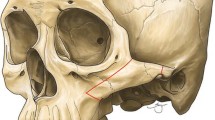Abstract
In the Orient, faces are usually wide and short. This physical characteristic is often undesirable in many Asian cultures. Consequently, reduction malarplasty is one of the most common aesthetic procedures performed in the Orient. Previously described techniques for malar reduction such as intraoral chiseling or the burring-down of the zygomatic body and arch often result in minimal invasiveness, with no external scarring. However, they are less effective techniques. Other techniques, such as osteotomy and repositioning of a prominent malar complex by means of a coronal approach also proved fallible, by often resulting in a prominent, visible scar. Furthermore, a combined approach, using both the intraoral and the external (preauricular or sideburn) routes, often results not only in an external scar, but also in possible facial nerve (frontotemporal branch) damage. Thus, we performed a true intraoral osteotomy and reduction malarplasty through upper buccal sulcus incisions, resulting in minimal tissue damage without external scarring. Aesthetic facial contouring surgery has been performed in increasing numbers over the past decade, especially for malar and mandibular angle protrusion. The prominence of the malar area varies according to differences in the inherited bony structure. Essentially, Orientals are mesocephalic, whereas Caucasians are dolichocephalic; the face is wider and shorter in the former than in the latter. An even greater prominence of the zygoma among Orientals, which causes the face to be wider and shorter, is widely regarded as an unattractive feature in the Oriental culture [1,2]. In contrast, a flat cheek bone in Caucasians makes the face appear masculine, in addition to making the nasal and chin prominences more noticeable. Of the previously described techniques for malar reduction, shaving and contouring by the intraoral approach, without the external approach [1,4] is often less effective due to the limitations of shaving. Likewise, osteotomy and repositioning of a prominent malar complex by the coronal approach can result in an extensive visible scar [2,5,6,12]. Additionally, the combined approach by means of the intraoral and external (preauricular or temporal, sideburn) routes [4,7] can result in an external scar and the distinct possibility of facial nerve damage [8]. Therefore, our team created a simple and effective way of conducting a true intraoral osteotomy and reduction malarplasty without external scarring and the instigation of facial nerve damage.
Similar content being viewed by others
References
Onizuka T, Watanabe K, Takasu K, Keyama A: Reduction malarplasty. Aesth Plast Surg7:121, 1983
Whitaker LA: Temporal and malar-zygomatic reduction and augmentation. Clin Plast Surg18:1, 1991
Gonzalez-Ulloa M: Building out the malar prominence as an addition to rhytidectomy. Plast Reconstr Surg53:293, 1974
Satoh K, Ohkubo F, Tsukagoshi T: Consideration of operative procedures for zygomatic reduction in Orientals: Based on a consecutive series of 28 clinical cases. Plast Reconstr Surg96:1298, 1995
Powell NB, Riley RW, Laub DR: A new approach to evaluation and surgery of the malar complex. Ann Plast Surg20:206, 1988
Baek S-M, Chung Y-D, Kim S-S: Reduction malarplasty. Plast Reconstr Surg88:53, 1991
Hwang YJ, Jeon JY, Lee MS: A simple method of reduction malarplasty. Plast Reconstr Surg99:348, 1997
Kim J, Choi HY: New aesthetic zygoma recessive osteotomy for the correction of zygoma protrusion. J Korean Plast Reconstr Surg18:6, 1991
Hinderer UT: Malar implants for improvement of the facial appearance. Plast Reconstr Surg56:157, 1975
Sumiya N, Kondo S, Ito Y, Ozumi K, Otani K, Wako M: Reduction malarplasty. Plast Reconstr Surg100:461, 1997
Lee CH, Lee C, Trabulsy PP, Alexander JT: A cadaveric and clinical evaluation of endoscopically assisted zygomatic fracture repair. Plast Reconstr Surg101:333, 1998
Longaker MT, Kawamoto HK Jr: Evolving thoughts on correcting posttraumatic enophthalmos. Plast Reconstr Surg101:889, 1998
Kim SB, Choi HY, Lew JM: Zygoma reposition with splitting osteotomy of zygomatic arch. J Korean Plast Reconstr Surg22:5, 1995
Author information
Authors and Affiliations
Rights and permissions
About this article
Cite this article
Choi, H.Y., Lee, S.W. & Lew, J.M. True intraoral reduction malarplasty with a minimally invasive technique. Aesth. Plast. Surg. 23, 354–360 (1999). https://doi.org/10.1007/s002669900298
Issue Date:
DOI: https://doi.org/10.1007/s002669900298




